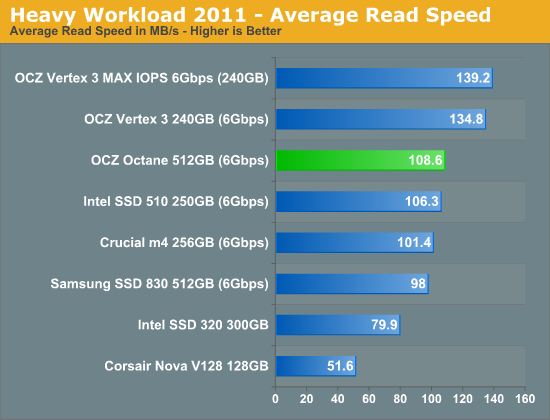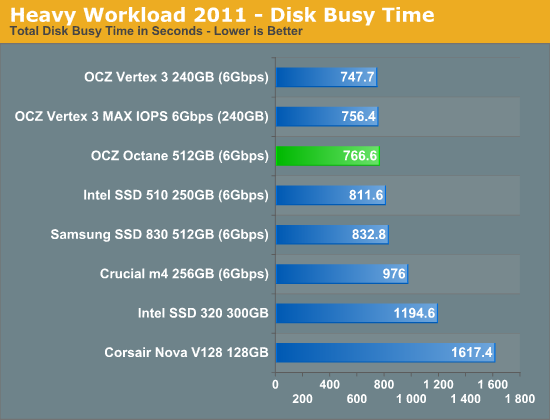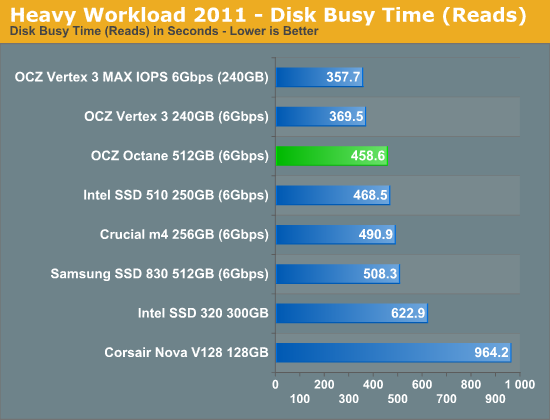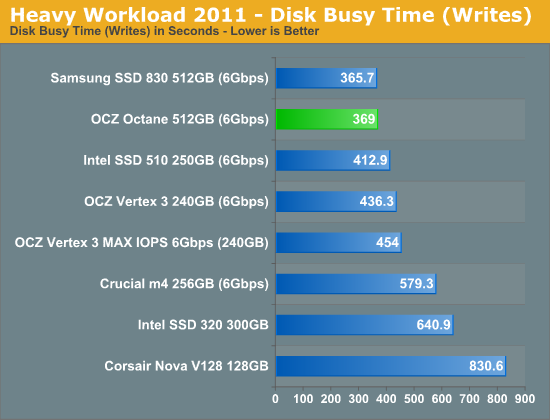The OCZ Octane Review (512GB)
by Anand Lal Shimpi on November 23, 2011 12:00 PM ESTAnandTech Storage Bench 2011
Last year we introduced our AnandTech Storage Bench, a suite of benchmarks that took traces of real OS/application usage and played them back in a repeatable manner. I assembled the traces myself out of frustration with the majority of what we have today in terms of SSD benchmarks.
Although the AnandTech Storage Bench tests did a good job of characterizing SSD performance, they weren't stressful enough. All of the tests performed less than 10GB of reads/writes and typically involved only 4GB of writes specifically. That's not even enough exceed the spare area on most SSDs. Most canned SSD benchmarks don't even come close to writing a single gigabyte of data, but that doesn't mean that simply writing 4GB is acceptable.
Originally I kept the benchmarks short enough that they wouldn't be a burden to run (~30 minutes) but long enough that they were representative of what a power user might do with their system.
Not too long ago I tweeted that I had created what I referred to as the Mother of All SSD Benchmarks (MOASB). Rather than only writing 4GB of data to the drive, this benchmark writes 106.32GB. It's the load you'd put on a drive after nearly two weeks of constant usage. And it takes a *long* time to run.
1) The MOASB, officially called AnandTech Storage Bench 2011 - Heavy Workload, mainly focuses on the times when your I/O activity is the highest. There is a lot of downloading and application installing that happens during the course of this test. My thinking was that it's during application installs, file copies, downloading and multitasking with all of this that you can really notice performance differences between drives.
2) I tried to cover as many bases as possible with the software I incorporated into this test. There's a lot of photo editing in Photoshop, HTML editing in Dreamweaver, web browsing, game playing/level loading (Starcraft II & WoW are both a part of the test) as well as general use stuff (application installing, virus scanning). I included a large amount of email downloading, document creation and editing as well. To top it all off I even use Visual Studio 2008 to build Chromium during the test.
The test has 2,168,893 read operations and 1,783,447 write operations. The IO breakdown is as follows:
| AnandTech Storage Bench 2011 - Heavy Workload IO Breakdown | ||||
| IO Size | % of Total | |||
| 4KB | 28% | |||
| 16KB | 10% | |||
| 32KB | 10% | |||
| 64KB | 4% | |||
Only 42% of all operations are sequential, the rest range from pseudo to fully random (with most falling in the pseudo-random category). Average queue depth is 4.625 IOs, with 59% of operations taking place in an IO queue of 1.
Many of you have asked for a better way to really characterize performance. Simply looking at IOPS doesn't really say much. As a result I'm going to be presenting Storage Bench 2011 data in a slightly different way. We'll have performance represented as Average MB/s, with higher numbers being better. At the same time I'll be reporting how long the SSD was busy while running this test. These disk busy graphs will show you exactly how much time was shaved off by using a faster drive vs. a slower one during the course of this test. Finally, I will also break out performance into reads, writes and combined. The reason I do this is to help balance out the fact that this test is unusually write intensive, which can often hide the benefits of a drive with good read performance.
There's also a new light workload for 2011. This is a far more reasonable, typical every day use case benchmark. Lots of web browsing, photo editing (but with a greater focus on photo consumption), video playback as well as some application installs and gaming. This test isn't nearly as write intensive as the MOASB but it's still multiple times more write intensive than what we were running last year.
As always I don't believe that these two benchmarks alone are enough to characterize the performance of a drive, but hopefully along with the rest of our tests they will help provide a better idea.
The testbed for Storage Bench 2011 has changed as well. We're now using a Sandy Bridge platform with full 6Gbps support for these tests.
AnandTech Storage Bench 2011 - Heavy Workload
We'll start out by looking at average data rate throughout our new heavy workload test:

When put to the test the Octane does not disappoint. It's within a couple MB/s of the SF-2281 based Vertex 3, and effectively one of the fastest 6Gbps drives on the market today. I included the old Indilinx Barefoot based Corsair Nova V128 to show just how far Indilinx has come here.


The next three charts just represent the same data, but in a different manner. Instead of looking at average data rate, we're looking at how long the disk was busy for during this entire test. Note that disk busy time excludes any and all idles, this is just how long the SSD was busy doing something:













75 Comments
View All Comments
pandemonium - Wednesday, November 23, 2011 - link
Thanks for the article. That was quite interesting hearing about your personal interactions with OCZ and your perceptions. Of course, the number crunching data is always appreciated as well!Locut0s - Thursday, November 24, 2011 - link
IMO they really only turned a new leaf with their SSDs and their decision to abandon memory sales. All of which was in the last few years.Beenthere - Thursday, November 24, 2011 - link
I'm not sure they've ever "turned a new leaf"... ? Their SSDs also have issues which is why people should WAIT for 6 months or so to see how many firmware updates are required and if they actually fix all of the OCZ SSD Octane issues discovered.FunBunny2 - Friday, November 25, 2011 - link
Yeah, and then get a huge discount at Newegg!!lancid81 - Thursday, November 24, 2011 - link
Which SSD do you use for your personal computer at home Anand ? or i guess thereal question is if you had to purchase an SSD with your own cash..which would you go for?
Thanks for all the great reviews
Anand Lal Shimpi - Thursday, November 24, 2011 - link
My personal system(s) all use SSDs I recommend. It's a part of the review process to be honest. I put in months of use case testing on top of the normal review to help me formulate exactly these types of opinions.I've got both the Intel SSD 510 and Samsung SSD 830 in my main work computer at this point. If I had to spend money on one right now it'd probably be the Samsung.
Take care,
Anand
jihe - Thursday, November 24, 2011 - link
OCZ, now that's three letters I'd like to avoid at all costs.ppro - Thursday, November 24, 2011 - link
I just post a link to this anadtech post and they removed the post on ocz forum... go and try... they even ban your account.NO OCZ anymore... awful customer support + BSOD on all series 3 OCZ drives
Beenthere - Thursday, November 24, 2011 - link
There have been lots of issues in both the OCZ and Corsair forums when they get over-protective of even mentioning a competitors brand/product. I understand the challenges and bickering that can occur in these forums but the moderation of these forums leaves a LOT to be desired IME and is often counter-productive to supporting the brand.TinHat - Friday, November 25, 2011 - link
BeHardware - by Marc PrieurPublished on November 16, 2011
http://www.behardware.com/articles/843-1/component...
Components returns rates - SSD's (page 7), Memory (page 4)
If i'm reading this article right, I see from the stats provided by Behardware that OCZ still have very poor return rates for their SSD drives currently at 4.2%. In contrast Intel has a ultra low 0.1% return rate whilst Corsair (their nearest competitor) has only 2.9% fail rate. I appreciate this could be attributed to the controller bug nightmare that seemed to drag on forever but how do they explain why other competitor brands, using the same chip, seemed to have no problems at all? In addition to this why their memory return rates are the highest to date at 6%?
If these stats are to be believed then OCZ product failure rates are still not very reassuring, especially when you consider the prices of their products and all the consumer hasstle when dealing with component failures. Intel and Kingston seem to be the better bet at this time.